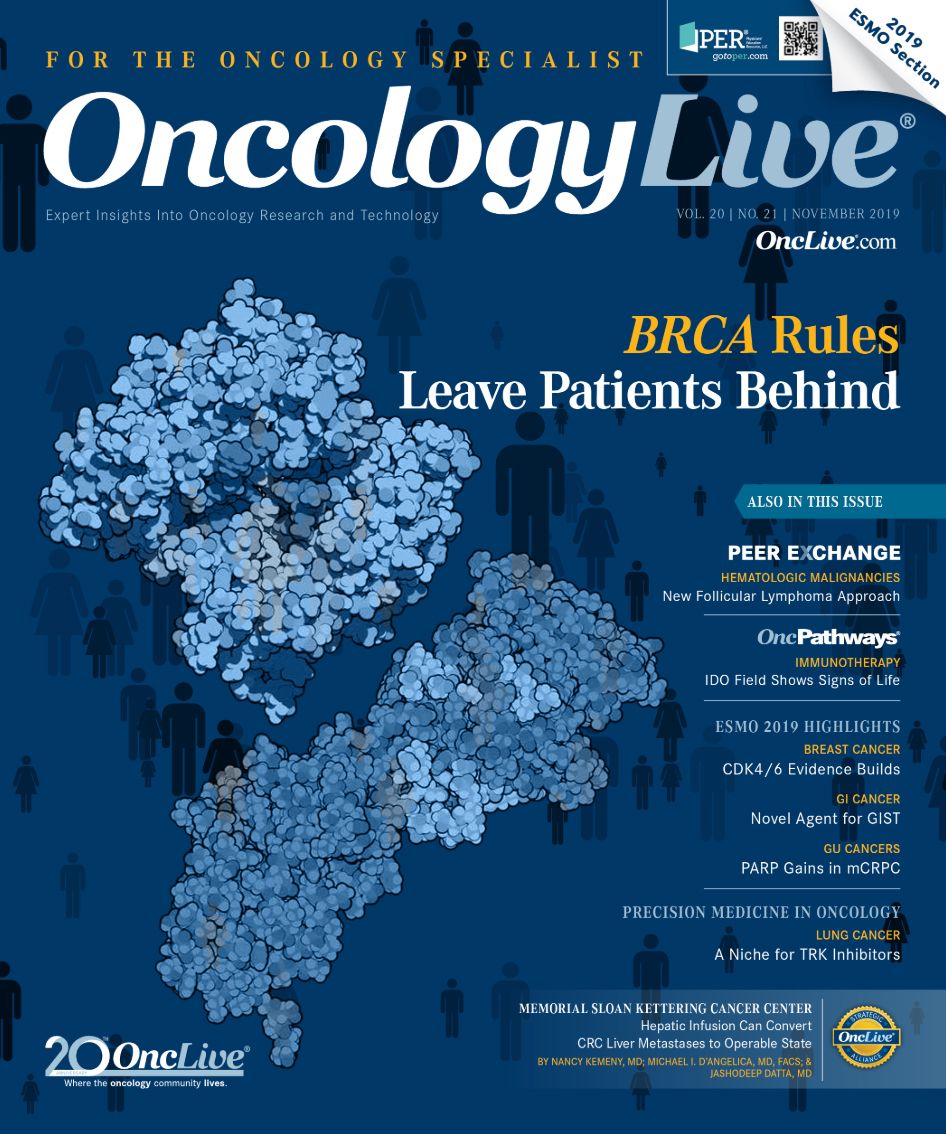Publication
Article
Oncology Live®
Rising Incidence of Fatty Liver Disease Holds Implications for Trends in HCC
Author(s):
Nonalcoholic fatty liver disease, a risk factor linked to the development of hepatocellular carcinoma and increased mortality, is growing in clinical significance.
Katherine A. McGlynn, PhD, MPH, senior investigator in the Division of Cancer Epidemiology and Genetics at the National Cancer Institute

Katherine A. McGlynn, PhD, MPH
Nonalcoholic fatty liver disease (NAFLD), a risk factor linked to the development of hepatocellular carcinoma (HCC) and increased mortality, is growing in clinical significance, according to Katherine A. McGlynn, PhD, MPH.
McGlynn and colleagues studied data from patients who underwent an abdominal ultrasound in the Third National Health and Nutrition Examination Survey (NHANES III) study between 1988 and 1994. This allowed for 21 to 27 years of follow-up of mortality after the initial ultrasound.
NAFLD was seen in 33% of the patients examined in this analysis (35% of males and 31% of females). Additionally, NAFLD was seen more commonly in Mexican Americans; about 40% had NAFLD compared with 32% of Caucasians and 29% of African Americans. Age also appeared to play a role in the development of NAFLD, because about 40% of patients 50 years and over had NAFLD compared with 20% of those younger than 50 years.
About one-third of deaths in the patients studied were caused by cardiovascular disease, with cancer—notably HCC—as the second leading cause. Other risk factors that played a role in mortality among these patients included excessive alcohol consumption, smoking, and obesity. McGlynn presented the findings at the 2019 International Liver Cancer Association Annual Conference.
In an interview with OncologyLive®, McGlynn, senior investigator in the Division of Cancer Epidemiology and Genetics at the National Cancer Institute, discussed the population attributable fraction of NAFLD in developing HCC, as well as related disorders, in the United States that contribute to mortality risk.
OncologyLive: Could you provide the rationale for population analysis of patients with HCC?
McGlynn: We [looked at] rates of HCC around the world and in the United States. Rates in the United States may have plateaued and started to decline, which is very good news. However, several years ago when we started studying why rates were going up, we calculated population attributable fractions, which we did for all of the risk factors that we could [measure] using data from the SEER [Surveillance, Epidemiology, and End Results] Medicare Program. The cancer diagnosis comes from SEER, the data come from Medicare, and this gives you a good idea of what contributions the risk factors make.
We calculated odds ratio, and using [those] and prevalence of the population, we calculated population attributable risks for the risk factors. We found that although hepatitis C virus (HCV) and hepatitis B virus (HBV) have, by far, the biggest odds ratios [for developing HCC], and they are the biggest risk to the individual themselves, on a population basis, the metabolic disorders and NAFLD make a much bigger contribution because they are much more common in the population.
We also looked at the contribution of NAFLD to overall mortality in the population because if you’re just concentrating on HCC, that is a fairly rare outcome, but in terms of total population mortality [it was a significant contribution]. We used data from the NHANES III population to look at risk of mortality among people who had NAFLD and among people who did not. We found a significantly increased risk of mortality in people who have NAFLD, and a significantly increased risk of diabetes mortality. Among men, there was also a significantly increased risk in liver disease mortality. I think those are very important findings and will need to be followed because, unfortunately, the risk of NAFLD is increasing in the population [as] obesity[rates rise].
What do you think is contributing to the decline in HCC in the United States?
We are not entirely sure, but it could be that HCV as a risk factor is diminishing now, although the rate of decline started around 2012. That was before any of the direct-acting antivirals were able to have a big effect in the population. We are not entirely sure what’s going on because the percentage of the population that was supposed to [be affected by] the big HCV effect were the Baby Boomers born between 1945 and 1965. The projections [regarding] the Baby Boomers and HCC were based on them having a big risk of HCC over time. However, the decline started happening when the average Baby Boomer was 57 years old, which is before the [mean] age of HCC [onset].
In the population, the mean age of HCC [onset] in men is about 62 years and in women it’s about 68 years. Having this peak out when Baby Boomers [reached age] 57 was a little unexpected, but it could be that [those with] HCV are just doing better. Treating HBV probably has very little effect because HBV is a much less significant risk factor in the population, so we are not quite sure what’s going on yet.
What risk factors did you look at?
We looked at HCV, obviously, which was long thought to be a driving risk in the United States. We [also] looked at HBV, excessive alcohol consumption, smoking to some extent, rare genetic disorders, and the metabolic disorders.
We found that, obviously, the biggest increased risk to the person was HCV—about a 50-fold increased risk of developing HCC if you have an HCV infection. With HBV, the risk was about 18-fold or higher. The genetic disorders and alcohol consumption were about a 7-fold increased risk.
The metabolic disorders, comparatively, were about a 3-fold increased risk, so you might think by looking at that, metabolic disorders aren’t contributing much, but you have to keep in mind that when you calculate odds ratios, you’re talking about the risk in a person who has that risk factor. It’s not a population perspective, really. It’s just if you have a particular risk factor.
What we did then to calculate the population’s attributable risk is take into account both the odds of developing HCC and the prevalence in the population. Once you do that, metabolic disorders rise to the top; about 35% of tumors were related to the metabolic disorders, including NAFLD-impaired, fasting-glucose, metabolic syndrome. We also got medical codes for obesity and diabetes in there. It was basically any of this whole group of disorders that are very highly correlated, so 35% of tumors in the population related to those [disorders] is fairly impressive.
HCV was second, in about 20% of tumors, and then, as you went down, fewer and fewer percentages of tumors were related. HBV was only about 4%, for example. Of course, they differed by sex, race, and ethnicity. HCV had a much bigger effect in blacks. The metabolic disorders have a bigger effect in whites and Hispanics. It’s always good to keep in mind that we are a multiracial, multiethnic population, so you have to account for differences. Also, there were differences by sex.
Could you discuss the risk of mortality in these patients?
As I mentioned, [these calculations were made with data from] the NHANES III study. NHANES III is a cross-sectional study of the population that is going on in the United States somewhere all the time. We used data from the [portion of the] NHANES III that took place between 1988 and 1994. We wanted to use that particular version of it because abdominal ultrasound was done for the adults during that part of the study, and you get a much better feel for NAFLD using abdominal ultrasound than you do using any of these indices, which rely on the combination of factors like liver enzymes and so on.
The other reason we wanted to use NHANES III was that it gave sufficient time for mortality events to occur. [If patients] were enrolled between 1988 and 1994, we had about 21 to 27 years of follow-up. Some other analyses that had been done were done after [about] 10 years of follow-up, which is insufficient time for deaths [to occur].
In the population, what we found was that about 32% to 33% of the population had NAFLD, which is a little bit higher than you’ve heard from some other [data] coming out. [This estimate, however,] was based on ultrasound, so I think it is accurate. NAFLD was more common among males; [it was found in] about 35% of males and 31% of females. So overall, it was more like 32% to 33%.
It was higher in Mexican Americans, which has been widely reported previously, at about 40%. [It was found in] about 32% of whites and again, as has been reported, in a lower percentage among blacks, around 29%. It was also higher with age: By the time you got to 50 years and over, about 40% of the population had NAFLD, versus 20% in younger patients.
We took those outcomes and we looked at the deaths and causes of death. About a third occurred among the individuals with NAFLD. More than a third of those were due to cardiovascular disease, which, again, was not a surprise because it was previously reported. Cancers were next, [followed by] deaths from liver disease, kidney disease, and diabetes. Of these, the ones that were significantly higher among individuals with NAFLD were all-cause mortality with about a 20% increased risk in diabetes mortality, which was about a 225% increased risk of death.
If you then calculate the population attributable fraction, it turns out that about 7.5% of people who die in the United States, have NAFLD-related mortality— at least in 2015. That doesn’t sound huge; it was about 200,000 of about 2.7 million deaths that year.
However, if you look at some other risk factors, it puts it into perspective because smoking accounts for anywhere between 18% and 25% of deaths. Obesity is probably around 18%, and that is, of course, a co-traveler with NAFLD. Alcohol is lower, at around 2% to 6%. Smoking is going down in the population, so in terms of being a major risk factor contributing to death, smoking, hopefully, will become less and less of a factor.
Unfortunately, obesity and, as a result, NAFLD, are increasing. [We thought] the latest data from NHANES III [would] show that the obesity epidemic had leveled off in the United States, but according to these data, it has unfortunately not. It’s gone up again. I think it’s a real problem, and one that needs to be taken seriously.
What does this analysis highlight about the future of patients with NAFLD?
We were surprised to see that while [HCC] rates may be going down, they may again level off because HCV can run a much higher risk to the person. So, if you have had HCV, your likelihood of developing HCC is great. That may have contributed to this big rise. Maybe what we are seeing is just a leveling off, and we will see it plateauing with NAFLD because NAFLD does not, by any stretch, have the same effect that HCV does. However, we all recognize with NAFLD that the biggest risk is not in developing HCC; it’s in developing cardiovascular disease. Cardiovascular disease rates have been going down in the United States for many years, so hopefully this is not going to bring them back up again.




























%20(2)%201-Recovered-Recovered-Recovered-Recovered-Recovered-Recovered-Recovered-Recovered-Recovered-Recovered-Recovered-Recovered-Recovered-Recovered-Recovered-Recovered-Recovered.jpg?fit=crop&auto=format)
%20(2)%201-Recovered-Recovered-Recovered-Recovered-Recovered-Recovered-Recovered-Recovered-Recovered-Recovered-Recovered-Recovered-Recovered-Recovered-Recovered-Recovered-Recovered.jpg?fit=crop&auto=format)
